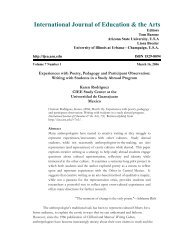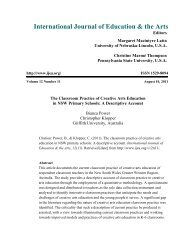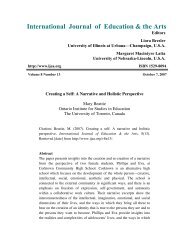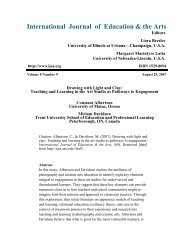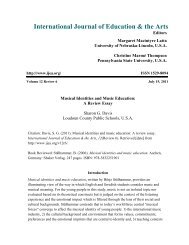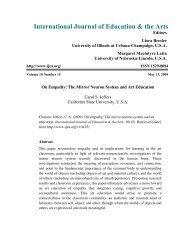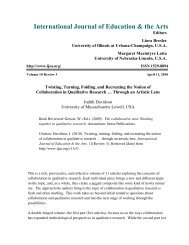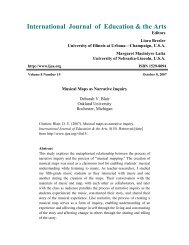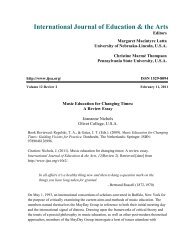The Rewards of Art Criticism in Art Education: A Review Essay ...
The Rewards of Art Criticism in Art Education: A Review Essay ...
The Rewards of Art Criticism in Art Education: A Review Essay ...
Create successful ePaper yourself
Turn your PDF publications into a flip-book with our unique Google optimized e-Paper software.
http://ijea.asu.edu/v7r2/ 2<br />
In this review I will analyze Barrett’s approach to <strong>in</strong>terpretation. Through his<br />
model<strong>in</strong>g <strong>of</strong> the 19 pr<strong>in</strong>ciples, Barrett exemplifies a passion for <strong>in</strong>quiry and artistic<br />
expression that is important to highlight as it may <strong>in</strong>spire art educators who want to<br />
conduct engag<strong>in</strong>g and mean<strong>in</strong>gful criticism with their students. While all 19 pr<strong>in</strong>ciples<br />
are critical, I will focus on six, specifically those relat<strong>in</strong>g to multiplicity <strong>of</strong><br />
<strong>in</strong>terpretation, and the need for reasonable <strong>in</strong>terpretations that correspond to a<br />
particular work <strong>of</strong> art.<br />
1. <strong>Art</strong>works attract multiple <strong>in</strong>terpretations and it is not the goal <strong>of</strong><br />
<strong>in</strong>terpretation to arrive at s<strong>in</strong>gle, grand, unified, composite <strong>in</strong>terpretations<br />
2. <strong>The</strong>re is a range <strong>of</strong> <strong>in</strong>terpretations any artwork will allow<br />
3. Interpretations are not so much right, but are more or less reasonable,<br />
conv<strong>in</strong>c<strong>in</strong>g, <strong>in</strong>formative, and enlighten<strong>in</strong>g<br />
4. Good <strong>in</strong>terpretations tell more about the artwork than they tell about the<br />
<strong>in</strong>terpreter<br />
5. Some <strong>in</strong>terpretations are better than others<br />
6. <strong>The</strong> admissibility <strong>of</strong> an <strong>in</strong>terpretation is ultimately determ<strong>in</strong>ed by a<br />
community <strong>of</strong> <strong>in</strong>terpreters and the community is self-correct<strong>in</strong>g<br />
I have selected to focus on these six because Barrett does a particularly good job <strong>of</strong><br />
address<strong>in</strong>g the relativism that might exist <strong>in</strong> some K-12 art education classrooms where<br />
there are “no wrong answers.” I th<strong>in</strong>k it may be useful to art educators to understand<br />
how Barrett encourages a multitude <strong>of</strong> <strong>in</strong>terpretations while requir<strong>in</strong>g correspondence<br />
with the work <strong>of</strong> art. In order to explicate his ideas I will provide a brief outl<strong>in</strong>e <strong>of</strong> the<br />
book. <strong>The</strong>n, I will present an analysis <strong>of</strong> Barrett’s approach to <strong>in</strong>terpret<strong>in</strong>g art and<br />
suggest some practical applications. Next, I will discuss the six pr<strong>in</strong>ciples listed above.<br />
F<strong>in</strong>ally, I conclude with a discussion <strong>of</strong> the transformative potential <strong>of</strong> <strong>in</strong>terpret<strong>in</strong>g art.<br />
A Brief Outl<strong>in</strong>e<br />
<strong>The</strong>re are seven chapters that explore the 19 pr<strong>in</strong>ciples <strong>of</strong> <strong>in</strong>terpretation and an<br />
eighth chapter that summarizes the pr<strong>in</strong>ciples and ma<strong>in</strong> po<strong>in</strong>ts <strong>of</strong> the book. Barrett<br />
encourages the reader to go through the book as needed, suggest<strong>in</strong>g that one may start<br />
mean<strong>in</strong>gs <strong>of</strong> artworks are not limited to what their artists <strong>in</strong>tended them to mean; i)<br />
<strong>in</strong>terpretations are not so much right, but are more or less reasonable, conv<strong>in</strong>c<strong>in</strong>g, <strong>in</strong>formative,<br />
and enlighten<strong>in</strong>g; j) <strong>in</strong>terpretations imply a worldview; k) good <strong>in</strong>terpretations tell more about<br />
the artwork than they tell about the <strong>in</strong>terpreter; l) the objects <strong>of</strong> <strong>in</strong>terpretation are artworks,<br />
not artists; m) all art is <strong>in</strong> part about the world <strong>in</strong> which it emerged; n) all art is <strong>in</strong> part about<br />
other art; o) good <strong>in</strong>terpretations have coherence, correspondence, and <strong>in</strong>clusiveness; p)<br />
<strong>in</strong>terpret<strong>in</strong>g art is an endeavor that is both <strong>in</strong>dividual and communal; q) some <strong>in</strong>terpretations<br />
are better than others; r) the admissibility <strong>of</strong> an <strong>in</strong>terpretation is ultimately determ<strong>in</strong>ed by a<br />
community <strong>of</strong> <strong>in</strong>terpreters and the community is self-correct<strong>in</strong>g; s) good <strong>in</strong>terpretations <strong>in</strong>vite<br />
us to see for ourselves and cont<strong>in</strong>ue on our own.




